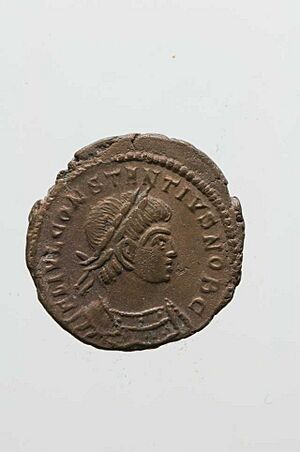Heslington Hoard facts for kids
Quick facts for kids Heslington Hoard |
|
|---|---|

Coin from the hoard depicting Constantius II, AD 330-335
|
|
| Material | Roman coins Roman pottery |
| Size | c.2,800 coins |
| Created | Shortly after AD355 |
| Period/culture | Romano-British |
| Discovered | 1966 Heslington, York, England |
| Present location | Yorkshire Museum, York |
| Identification | YORYM: 2014.395 |
The Heslington Hoard is a special collection of ancient coins. It was found in York, England. This amazing discovery dates back to the middle of the 4th century AD. The hoard contained about 2,800 coins. They were all kept safe inside a pottery pot. Today, you can see this exciting find at the Yorkshire Museum.
How the Hoard Was Found
The Heslington Hoard was discovered on March 1, 1966. It was found in a place called Heslington, near York. Workers were digging to build a new part of the University of York. This new building was going to be called 'College 3'. That's when they stumbled upon the ancient pot filled with coins!
What Was Inside the Hoard?
The Heslington Hoard held many interesting coins. More than half of them were copies of real coins. These copies were made around the same time as the originals. About 1,158 coins were actual, official coins.
Most of the coins were made of copper. They were from the 4th century AD. There were also two older silver coins. One was from an emperor named Tetricus I. The other was from Tacitus.
Many of the copper coins showed pictures of emperors from the Constantinian dynasty. This was a powerful family of Roman emperors. The newest coins in the hoard showed Emperor Julian. Experts believe the hoard was buried shortly after the year 355 AD.

